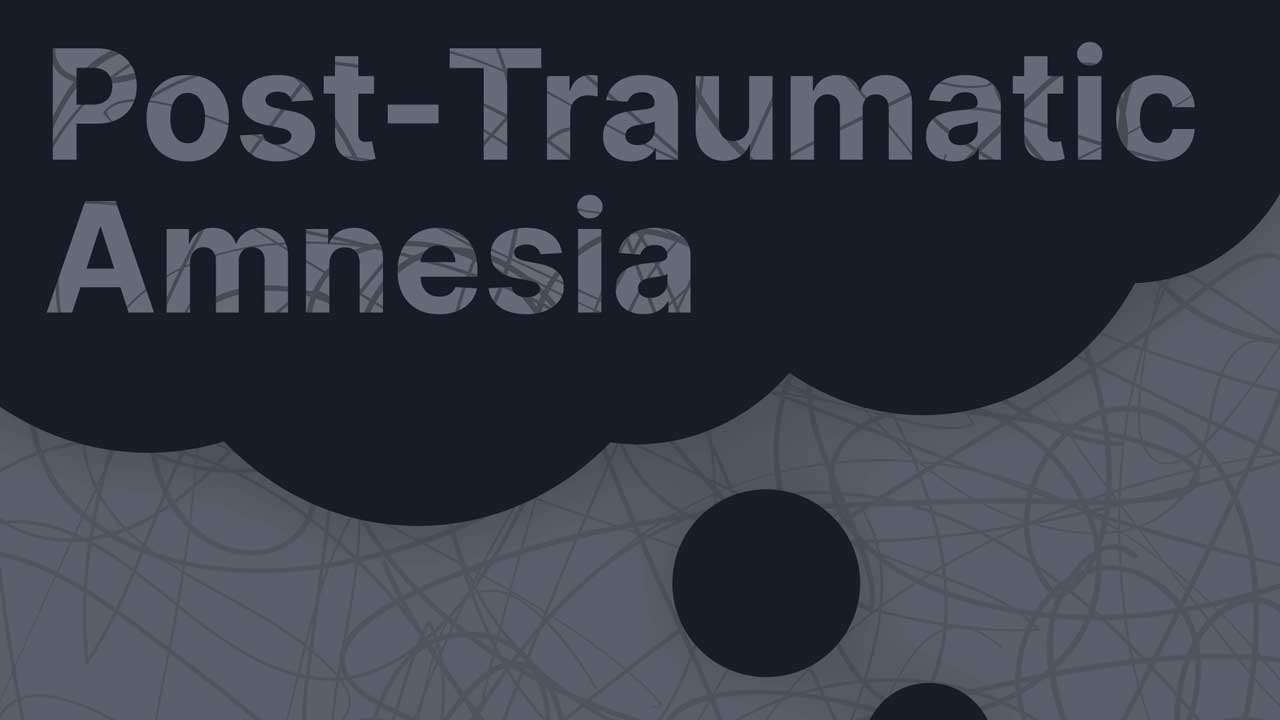A person who has suffered a traumatic brain injury might emerge from unconsciousness disoriented, confused and acting unlike themselves.
This can be a highly confronting and upsetting experience for their loved ones. So, what does this mean for the patient and their recovery?
What is Post-Traumatic Amnesia?
The term post-traumatic amnesia (PTA) refers to the state of confusion, disorientation and memory loss that can occur after a traumatic brain injury (TBI) (Ponsford et al. 2023).
PTA begins immediately after the injury (in cases where the patient does not lose consciousness) or immediately after the patient emerges from a coma or loss of consciousness, and lasts until the return of their continuous memory (Hull University Teaching Hospitals NHS Trust 2018; SABIN 2017).
This may last from a few minutes to several weeks, or even months (Hull University Teaching Hospitals NHS Trust 2018).
Symptoms of Post-Traumatic Amnesia

PTA is characterised by the loss of continuous memory, i.e. the inability to form new memories and recall day-to-day events (Headway 2015; SABIN 2017).
People experiencing PTA may also display signs and symptoms such as:
- Lack of awareness of the cause of their injury and what happened to them
- Confusion
- Disorientation to time, place and personal information
- Difficulty recognising others (e.g. family members)
- Agitation, irritability and restlessness
- Pacing and wandering
- Unreliable day-to-day memory and repetitive questioning
- Impaired attention and concentration
- Physical or verbal aggression
- Sensory over-stimulation
- Poor self-awareness, insight and judgement
- Impulsiveness and decreased awareness of safety
- Confabulation (creating false memories for things they can’t remember, without the intent to deceive)
- Lack of initiative (inability to commence tasks without being prompted to do so)
- Difficulty planning and problem-solving
- Mood changes (e.g. crying or being overly happy)
- Inappropriate social behaviour (e.g. sexual comments or gestures)
- Fear and paranoia
- Changes to sleeping habits
- Tiring easily
- Fixation on a certain object or activity
- Physical symptoms such as headaches, nausea, vomiting and dizziness.
(Gumm et al. 2020; Headway 2015; Cleveland Clinic 2023; SABIN 2017)
Assessing Post-Traumatic Amnesia
PTA is commonly assessed using the Westmead PTA Scale - a standardised tool that aims to provide an objective, prospective measure of PTA (SESLHD 2015).
There are two forms of the Westmead PTA Scale:
- The Westmead PTA Scale (WPTAS), which is used to assess moderate to severe TBI (patients presenting with a Glasgow Coma Scale score of under 13). The WPTAS involves asking the patient 7 questions to assess their orientation and 5 questions to assess their memory (12 in total). The test is performed daily until the patient scores perfectly (answers 12/12 questions correctly) for three consecutive days, which indicates that the patient is out of PTA.
- The Abbreviated Westmead Post-Traumatic Amnesia Scale (A-WPTAS), which is used to assess mild TBI (patients presenting with a GCS of 13 or more). The A-WPTAS is essentially the GCS with the addition of memory recall testing, which involves presenting the patient with three picture cards to learn and remember. An initial test should be performed within the first 24 hours following the injury, and the patient should then be re-tested hourly until they score 18/18 (15 points on the GCS plus 3 points for remembering the three images they were shown).
(Gumm et al. 2020; SESLHD 2023)
Factors to Consider When Assessing Post-Traumatic Amnesia
There are a variety of external factors that may complicate the assessment of PTA and affect testing results. These include:
- Pre-existing acquired brain injury or intellectual disability
- Lack of fluency in English
- Cultural differences
- Education level
- History of drug and/or alcohol abuse
- Taking medicines that affect alertness
- Existing or new speech or language impairment
- Unwillingness to engage or participate, frustration, agitation or anxiety
- Psychiatric illness
- Dementia and/or delirium
- Pain or physical morbidity
- Vision or hearing impairment.
(Monash Health 2020)
In these cases, WPTAS and A-WPTAS may not be the most appropriate tools to assess PTA and alternative screening methods may need to be explored (Monash Health 2020).
Post-Traumatic Amnesia and Severity of Brain Injury
As a general rule, the longer the patient spends unconscious, the longer PTA will last and the longer it will take them to recover. A longer period of PTA also indicates an increased likelihood of experiencing ongoing cognitive issues. Therefore, PTA is a good indicator of the severity of a TBI (SABIN 2017; Synapse 2025).
The following table can be used as a general guide to estimate the severity of a TBI by taking into account the patient’s initial Glasgow Coma Scale score and the duration of PTA:
| Severity | Mild | Moderate | Severe | Very severe |
| Initial GCS | 12-15 | 9-11 | 3-8 | < 1 |
| Duration of PTA | < 24 hours | 1-7 days | 1-4 weeks | > 4 weeks |
(Adapted from Synapse 2025)
Caring for Patients With Post-Traumatic Amensia

- Avoid sensory overload from noise and visual stimulation, (e.g. by dimming lights or turning off the television), however, note that in some cases, sensory stimulation may be soothing for the patient
- Ensure the care environment is safe, secure and familiar (e.g. by using family photos, music and objects from home)
- Remember that the patient is not in control of their actions and words at this time
- Avoid correcting errors or false beliefs as this can cause distress
- Avoid overloading the patient with information
- Give the patient plenty of time to process and respond when talking to them
- Allow the patient to rest adequately - they may need more sleep than usual
- Limit visitors (no more than two at once is best) and keep visits short
- Take note of factors that increase or decrease the patient’s agitation, and adjust these accordingly
- Reduce clutter in the patient’s immediate space
- Consider placing the patient in a single room to minimise sensory overload
- Avoid room changes where possible to prevent further disorientation
- Assess falls risk
- Assess pressure injury risk
- Use the patient’s preferred name when talking to them
- Give simple, clear and consistent instructions
- Involve the patient’s loved ones in their care
- Provide routine and structure to the patient
- Meet the patient’s immediate needs (e.g. personal care, meals)
- Reduce interruptions during mealtimes
- Remain calm if the patient becomes upset. Avoid arguing and try changing the subject or stopping the conversation
- Always supervise the patient if they leave the ward
- Remember that PTA can be highly distressing for the patient’s loved ones, so ensure you are empathetic in your interactions and keep them appropriately informed.
(Monash Health 2020; Gumm et al. 2020; Headway 2015; Hull University Teaching Hospitals NHS Trust 2018)
Test Your Knowledge
Question 1 of 3
True or false: As a general rule, a longer period of post-traumatic amnesia usually indicates a more severe brain injury.
Topics
Further your knowledge
References
- Cleveland Clinic 2023, Amnesia, Cleveland Clinic, viewed 8 July 2025, https://my.clevelandclinic.org/health/diseases/21455-amnesia
- Gumm, K, Taylor, T, Orbons, K, Carey, L & PTA Working Party 2020, Post Traumatic Amnesia Screening and Management Guideline, Royal Melbourne Hospital, viewed 8 July 2025, https://www.connectivity.org.au/wp-content/uploads/2022/08/TRM01.01-Post-Traumatic-Amnesia-Screening-and-Management-V5.1_06.20.docx.converted.pdf
- Headway 2015, Post-Traumatic Amnesia, Headway, viewed 7 July 2025, https://www.headway.org.uk/about-brain-injury/individuals/effects-of-brain-injury/post-traumatic-amnesia/
- Hull University Teaching Hospitals NHS Trust 2018, Understanding and Interacting With People in Post-Traumatic Amnesia Information for Relatives, Carers and Friends, National Health Service, viewed 7 July 2025, https://www.hey.nhs.uk/patient-leaflet/understanding-and-interacting-with-people-in-post-traumatic-amnesia/
- Monash Health 2020, Assessment and Management of Post-Traumatic Amnesia in Acute Traumatic Brain Injury (Adults), Monash Health, viewed 8 July 2025, https://www.scribd.com/document/548130867/Monash-Health-Procedure-Assessment-and-Managment-of-PTA-in-Acute-TBI-2020
- Ponsford, J, Trevena-Peters, J, Janzen, S et al. 2023, ‘INCOG 2.0 Guidelines for Cognitive Rehabilitation Following Traumatic Brain Injury, Part I: Posttraumatic Amnesia’, Journal of Head Trauma Rehabilitation, vol. 38, no. 1, viewed 7 July 2025, https://journals.lww.com/headtraumarehab/fulltext/2023/01000/incog_2_0_guidelines_for_cognitive_rehabilitation.3.aspx
- Scottish Acquired Brain Injury Network 2017, Post Traumatic Amnesia, SABIN, viewed 7 July 2025, https://www.acquiredbraininjury-education.scot.nhs.uk/impact-of-abi/cognitive-problems/memory/post-traumatic-amnesia/
- South Eastern Sydney Local Health District 2023, Assessment and Management of Acute Adult Traumatic Brain Injury in the Emergency Department (ED) and Trauma wards using the Abbreviated – Westmead Post Traumatic Amnesia Testing (A-WPTAS) and Post Traumatic Amnesia Testing (PTA), New South Wales Government, viewed 8 July 2025, https://www.seslhd.health.nsw.gov.au/sites/default/files/documents/SESLHDPR%20737%20-%20Assessment%20and%20Management%20of%20Acute%20~%20WPTAS%29%20and%20Post%20Traumatic%20Amnesia%20Testing%20%28PTA%29.pdf
- Synapse 2025, Determining Brain Injury Severity, Synapse, viewed 8 July 2025, https://synapse.org.au/fact-sheet/determining-brain-injury-severity/
 New
New 

